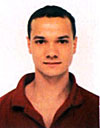Carmela CARPENTIERI
Albert-Ludwig Univ., Freiburg
carmen@physik.uni-freiburg.de

For my PhD thesis Iím working on the SemiConductor Tracker that is part of the ATLAS Detector. based upon silicon micro strip detector technology.
Each layer of this detector consists of silicon strip modules in which up to 4 single-sided silicon detectors are assembled back to back with a 40-mrad stereo orientation, this configuration gives a precision of 17micron in phi coordinate and 500 micron in the r coordinate for the tracks reconstruction, to maintain these resolution high quality module construction, metrology and position monitoring is required.
I'm working on the development of a semi-automatic assembly system that will give the possibility to assemble module with a tolerance whitin 5 micron and a metrology system for the quality assurance of this module.
Antoine CAZES
LAL, Orsay
cazes@lal.in2p3.fr

I am a PhD student interested in the oscillation of neutrino field and working on the OPERA experiment located in Gran Sasso, Italy. This experiment is aiming at finding direct evidence of the oscillation between mu and tau neutrinos, by observing tau neutrinos appearance in the CNGS beam which is initially composed of mu neutrinos. The distance travelled by the beam (732 km) is optimised for the oscillation. I have been involved on the OPERA target tracker, working on the track reconstruction and on the muon identification sofware. This is a crucial point to discreminate the signal (tau -> mu numu nutau) from the background (nu mu CC interaction, and charme production). I have also been working on neutrino factory project. I simulate the electromagnetic horn that collects the pions necessary to create the mu neutrino beam. I am involved in study of the collecting efficiency and beam focalisation. Also technical constraint must be assessed.
Alexis COTHENET
IN2P3, Marseille
cothenet@cppm.in2p3.fr

Peter CWETANSKI
University of Helsinki
Peter.Cwetanski@cern.ch

For my PhD thesis I am working with the ATLAS Transition Radiation Tracker (TRT) group. Upon arrival at CERN, all TRT modules (wheels and barrels) will go through an inspection process and will only be accepted if they successfully pass specified tests. These acceptance tests concern wire tension and position, gas-tightness, high voltage training and gas gain uniformity. I participate in building up a fully equipped end-cap wheel test site at CERN, with particular focus on a gas monitor system and analysis of the acceptance test data. Further involvements in the various acceptance tests are foreseen for the future.